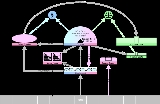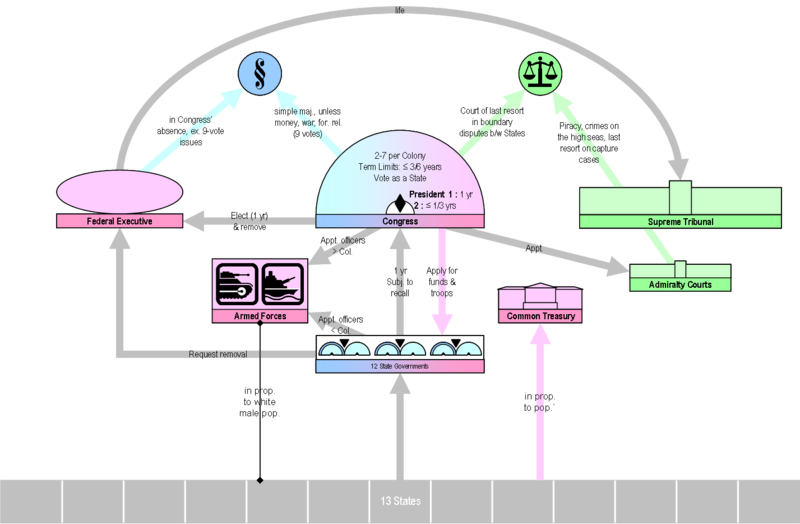
New Jersey Plan
Encyclopedia
The New Jersey Plan was a proposal for the structure of the United States Government
proposed by William Paterson at the Constitutional Convention on June 15, 1787. The plan was created in response to the Virginia Plan
's, calling for two houses of Congress, both elected with apportionment
according to population or direct taxes paid. The less populous states were adamantly opposed to giving most of the control of the national government to the larger states, and so proposed an alternate plan that would have given one vote per state for equal representation under one legislative body (i.e., a Unicameral Legislature). This was a compromise for the issue of the houses. This plan was opposed by James Madison
and Edmund Randolph
(The proponents of the Virginia Plan).
When the Connecticut Compromise
(or "Great Compromise") was constructed, the New Jersey Plan's legislative body was used as the model for the United States Senate
.
Under the New Jersey Plan, the organization of the legislature was similar to that of the modern day United Nations
and other similar institutions. This position reflected the belief that the states were independent entities, and, as they entered the United States of America freely and individually, so they remained. The New Jersey plan also gave power to regulate trade and to raise money by taxing all foreign goods.
Ultimately, the New Jersey Plan was rejected as a basis for a new constitution. The Virginia Plan was used, but some ideas from the New Jersey plan were added. In the Senate each state would be represented equally while the House of Representatives votes would be distributed according to population.

Federal government of the United States
The federal government of the United States is the national government of the constitutional republic of fifty states that is the United States of America. The federal government comprises three distinct branches of government: a legislative, an executive and a judiciary. These branches and...
proposed by William Paterson at the Constitutional Convention on June 15, 1787. The plan was created in response to the Virginia Plan
Virginia Plan
The Virginia Plan was a proposal by Virginia delegates, for a bicameral legislative branch. The plan was drafted by James Madison while he waited for a quorum to assemble at the Constitutional Convention of 1787...
's, calling for two houses of Congress, both elected with apportionment
Apportionment (politics)
Apportionment is the process of allocating political power among a set of principles . In most representative governments, political power has most recently been apportioned among constituencies based on population, but there is a long history of different approaches.The United States Constitution,...
according to population or direct taxes paid. The less populous states were adamantly opposed to giving most of the control of the national government to the larger states, and so proposed an alternate plan that would have given one vote per state for equal representation under one legislative body (i.e., a Unicameral Legislature). This was a compromise for the issue of the houses. This plan was opposed by James Madison
James Madison
James Madison, Jr. was an American statesman and political theorist. He was the fourth President of the United States and is hailed as the “Father of the Constitution” for being the primary author of the United States Constitution and at first an opponent of, and then a key author of the United...
and Edmund Randolph
Edmund Randolph
Edmund Jennings Randolph was an American attorney, the seventh Governor of Virginia, the second Secretary of State, and the first United States Attorney General.-Biography:...
(The proponents of the Virginia Plan).
When the Connecticut Compromise
Connecticut Compromise
The Connecticut Compromise was an agreement that large and small states reached during the Constitutional Convention of 1787 that in part defined the legislative structure and representation that each state would have under the United States Constitution...
(or "Great Compromise") was constructed, the New Jersey Plan's legislative body was used as the model for the United States Senate
United States Senate
The United States Senate is the upper house of the bicameral legislature of the United States, and together with the United States House of Representatives comprises the United States Congress. The composition and powers of the Senate are established in Article One of the U.S. Constitution. Each...
.
Under the New Jersey Plan, the organization of the legislature was similar to that of the modern day United Nations
United Nations
The United Nations is an international organization whose stated aims are facilitating cooperation in international law, international security, economic development, social progress, human rights, and achievement of world peace...
and other similar institutions. This position reflected the belief that the states were independent entities, and, as they entered the United States of America freely and individually, so they remained. The New Jersey plan also gave power to regulate trade and to raise money by taxing all foreign goods.
Ultimately, the New Jersey Plan was rejected as a basis for a new constitution. The Virginia Plan was used, but some ideas from the New Jersey plan were added. In the Senate each state would be represented equally while the House of Representatives votes would be distributed according to population.


